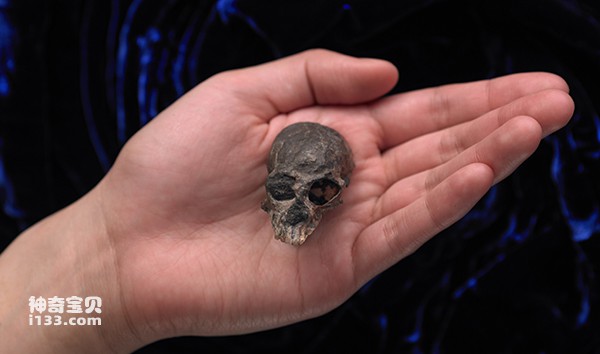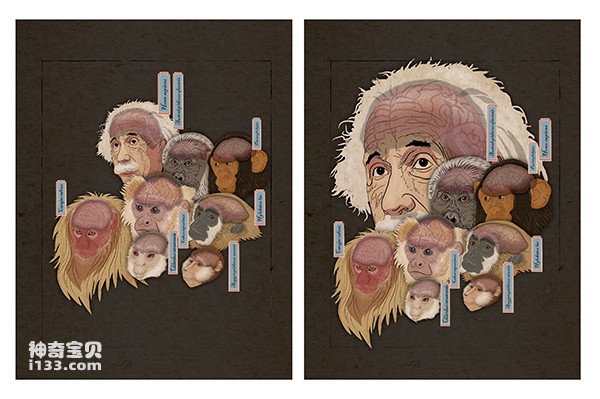The human brain is larger than other primates in both absolute and relative capacity, and its sulcus structure is also more complex. The traditional view is that the enlarged human brain is the result of gradual accumulation in the process of evolution, and generally continues the trend of primates' relative brain volume gradually increasing and their sulcus structure becoming more complex.
In the long systematic evolutionary history of great apes, there is no clear answer before this study as to when the human-type brain began to be different from other great apes, at what speed it increased, and when it began to be called a human brain. Recently, the research team of Ni Xijun of the Institute of Vertebrate Paleontology of the Chinese Academy of Sciences published the latest study in the sub-journal of Science Advances, using Chilecebus carrascoensis, a basal platyrrhine monkey living in South America. The fossils serve as "correction points" to reconstruct the characteristics of the brains of the ancestral types of great apes of platyrrhine monkeys and steno-nose monkeys, analyze the enlargement process of the great apes' brains, and then try to answer the above-mentioned questions about the evolution of the human brain.
To interpret the evolutionary history of any organism, fossils are essential evidence. The brain of an animal is a soft tissue. After the animal dies, it will be decomposed by microorganisms within a short period of time and cannot become a fossil. However, the mammalian brain is a significantly enlarged organ, and during growth and development, brain imprints will be left on the inner wall of the skull. Because great apes tend to have larger brains than other mammals of the same weight, the brain enlargement is more obvious, and the imprints left on the inner wall of the skull are clearer, often preserving large blood vessels and major grooves. The overall shape of the impression is very similar to that of the brain wrapped in the dura mater.
The research team used high-precision CT scanning to digitally three-dimensionally reconstruct the brain imprint on the inner wall of the skull of the Chilean monkey of Carrasco, and found that it has a relatively flat frontal lobe, but a well-developed occipital lobe, and a relatively small olfactory bulb. , and there are multiple pairs of sulci, and the overall shape is even equivalent to the living platyrrhine monkey marmoset.
Chilean monkey fossils were found about 100 kilometers southeast of Santiago, the capital of Chile, and were buried in hard volcaniclastic rocks. It is the most complete preserved basal platyrrhine ape known so far, dating back about 20 million years.
The platyrrhine monkeys are one of the two major branches of the crown group of great apes. As early as 40 million years ago, the platyrrhine monkeys began to interact with another large branch of the great apes including humans, that is, the stenorhin monkeys. We parted ways. The platyrrhine monkeys have since evolved independently, developing many advanced brain features in parallel with humans and steno-nose monkeys. The relative size of the brains of some platyrrhine monkeys has also increased significantly, and is comparable to that of apes belonging to the steno-nose monkeys. Some platyrrhine monkeys, such as capuchin monkeys, use simple tools, and some believe capuchin monkeys are even more intelligent than chimpanzees.
There is no doubt that platyrrhine monkeys are the natural frame of reference for studying the brain evolution of narrow-nose monkeys, including humans, and the Chilean monkey of Carrasco is currently the most critical reference point known in this frame of reference.
In the study of the evolutionary lineage of primates, especially great apes, the research team has established a stable relationship between primates and great apes based on previous studies, integrating fossil evidence, morphological characteristics and molecular biological characteristics. phylogenetic lineage. In the new study, the researchers used cutting-edge statistical methods and made full use of the super computing power of the supercomputing platform of the Key Laboratory of Vertebrate Evolution and Human Origins of the Chinese Academy of Sciences to further accurately estimate the divergence time and brain capacity of each branch of great apes. and the evolution pattern of brain macroscopic characteristics, and proposed the Phylogenetic Encephalization Quotient, a new index for measuring the evolution of brain volume .
Researchers found that the ancestors of broad-nosed monkeys and narrow-nosed monkeys had brains of relatively similar size but different structures. In the evolutionary history of more than 40 million years, both groups have a trend of increasing brain size, except for the human branch. Except for the other two systems, the growth ratios of the two are very similar, and they have convergently evolved macroscopic features such as the shrinkage of the olfactory bulb and the increase of sulci.
Since the human branch evolved separately from the great apes 7 million years ago, the increase in brain size is completely different from the increase in other great apes. Relative to body weight and excluding factors accumulated through evolution, the relative brain capacity of humans is more than three times that of apes. It can be said that since the separation of apes 7 million years ago, the most remarkable feature of the human branch is that the brain has developed rapidly according to an evolutionary model different from other apes.
There are many studies showing that compared with our close relatives, chimpanzees, humans have many new genes, and these new genes are often related to the development of the human brain. Based on this, the researchers believe that this study has found the evolutionary reason for this phenomenon.
Using Chilean monkeys as a reference point, this study revealed that the brain evolution trends of different branches of great apes will be the same, but the evolutionary trends of the human brains are significantly different. Joking a bit, if nature is rational, then the human brain must be bordering on crazy.

Figure 1: The fossilized skull of a Chilean monkey of Carrasco held in the palm of a hand. (Photo courtesy of AMNH/N. Wong and M. Ellison)

Figure 2: The size of each avatar represents relative brain capacity. Left: Without considering evolutionary accumulation, the relative size of the human brain is not much different from that of other great apes; right: After removing the factor of evolutionary accumulation, the relative size of the human brain is significantly different from other great apes. (Photo courtesy of IVPP/Guo Xiaocong, Ni Xijun)
animal tags:
We created this article in conjunction with AI technology, then made sure it was fact-checked and edited by a Animals Top editor.